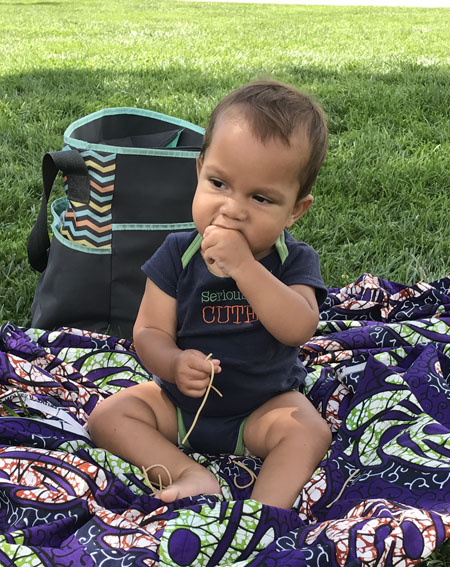Cookbook #214: Making Your Own Baby Food, Mary Turner and James Turner, Bantam Books, NY, 1978.

I bought Making Your Own Baby Food when I was preparing to feed my first child his first solid foods. I think I probably bought this little paperback in a used book store.
I invite you to read my post Feed Me I’m Yours for more of my thoughts on the topic of homemade baby foods – I use my grandchildren as my test subjects!
In both books, the advantages of and recommendations for homemade baby foods pretty much agree with current advice given to new moms, except for the “no honey until a year old” rule. Also, some milk products and some foods known to be potential allergens are introduced more carefully these days (peanuts, for instance). Making Your Own Baby Food is a lot more serious than Feed Me I’m Yours, a book I described as “friendly and helpful”.
The introduction of Making Your Own Baby Food begins with the authors (a couple) relating how they began to study the nutritive value of foods when Mary Turner (the wife) was two months pregnant. They quickly changed their own diets, taking out the multiple daily sugary drinks. And then they delved a lot more into the subject of the foods we are offered by the food industries. They express their strong belief that the food industry does not necessarily produce food of good nutritional quality for its consumers, and more importantly, for baby foods. They back up their statements with bibliographic references. The print is small. Hence I call it a “serious” book. And I have to get out strong glasses to read it.
Part I is “Getting in Gear”. This section discusses how to start changing your diet for the better and how to prepare to nourish your unborn and then newborn child. Part II is “What You Should Kuow [sic] About the Baby Food Industry”. Here is a quote from this section:
“Foods that are specifically prepared for babies require separate consideration from all other foods as regards the use of food additives and toxicological risks. The reason for this is that the detoxicating mechanisms that are effective in the more mature individual may be ineffective in the baby. The Committee [WHO Committee] strongly urges that baby foods should be prepared without food additives, if possible. If the use of a food additive is necessary in a baby food, great caution should be exercised both in the choice of additive and in the level of use.” (excerpt from a 1962 World Health Organization publication)
Parts I and II are fully half of the book: this is not simply a recipe book.
Part III is “The Alternatives”. This section first discusses how to put in action a good nutrition plan for mom and baby, including breastfeeding. Breastfeeding is now quite common in the US (2017). But when I had my son in 1980, breastfeeding was only coming back as an upward trend, after a hiatus in the 1950s and 60s. For instance, my own mother was encouraged to use formula. Today breastfeeding in our area of America is encouraged – and they have human-milk banks for moms who are unable to breastfeed.
The discussion of how to transition from milk to solids begins: “Going from a diet made up entirely of milk to one which includes a few solids is an important step in an infant’s life.” And:
“Nutritionists state:
- Food should be nutritious.
- It should be accepable [sic] to the infant and its family.
- It should be possible to prepare without excessive effort.
- It should be clean and prepared in clean surroundings.”
Next in “Part III: Alternatives” is “doing your own thing”. Parents are encouraged not to buy a big variety of foods for baby (apparently this was suggested by many pediatricians in1978), or to buy foods specifically labeled as “baby foods”. The theme of Making Your Own Baby Food is keep it simple, and to use foods you have on hand.
A few quotes from this section:
“The young baby and child are not known for their discriminating desire for gourmet foods.”
“Our parents and grandparents did not eat food until they were able to sit up at the table and nibble at small bits of food from a parent’s plate.”
“Keeping this in mind, you will learn in the pages ahead a number of simple recipes for baby food which parents are now using in their attempts to give their children more nutritious meals.”
Supplies for making baby food are in the excerpt below. Blenders today can still be purchased for as low as $20, pretty amazing. I bought a mini-jar attachment for my old Osterizer, and I still own it – even the screw-top lid. Baby grinders are readily available.
 Here is my Osterizer mini-jar:
Here is my Osterizer mini-jar:
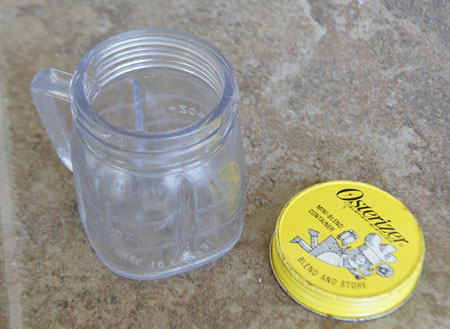 It still works with my current Osterizer blender. I should try it sometime!
It still works with my current Osterizer blender. I should try it sometime!
I got a kick out of the excerpt below on “Shopping”. Check out local stores? Yeah, I do that! I consider it a hobby. But then again, back in the 1970s some of the “health food” stores were pretty iffy. I remember several as dank with wooden floors, with organic produce that was spotty and marginal, and shelves stuffed with all sorts of odd and interesting items. Today’s markets such as Whole Foods are a couple generations bright and cleaner and are more comprehensive. (But they sure have a lot of flashy-packaged products.)

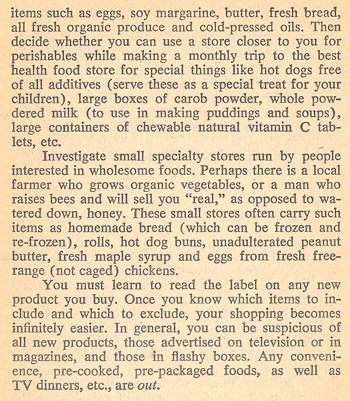 Did you catch that last paragraph? “In general, you can be suspicious of all new products, those advertised on television or in magazines, and those in flashy boxes.” Can one even find a package of food these days that is not in a flashy package??
Did you catch that last paragraph? “In general, you can be suspicious of all new products, those advertised on television or in magazines, and those in flashy boxes.” Can one even find a package of food these days that is not in a flashy package??
Part III gets – finally! – to the recipes. Only one-quarter of this book is recipes! I guess I’m a recipe sort of person.
The first recipe is “Banana”. 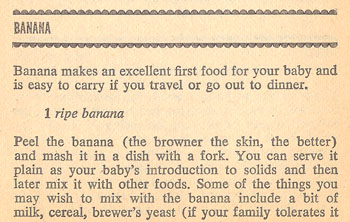
![]() First vegetables include acorn squash. I mention this because when I was babysitting a couple weeks ago, my 7 month old ate acorn squash – so it can be my “recipe” for this blog. My daughter put an acorn squash in the oven, and I took it out 45 minutes later. All I did was take it out and let it cool, then fed some to little Kekeli. He liked it!
First vegetables include acorn squash. I mention this because when I was babysitting a couple weeks ago, my 7 month old ate acorn squash – so it can be my “recipe” for this blog. My daughter put an acorn squash in the oven, and I took it out 45 minutes later. All I did was take it out and let it cool, then fed some to little Kekeli. He liked it!
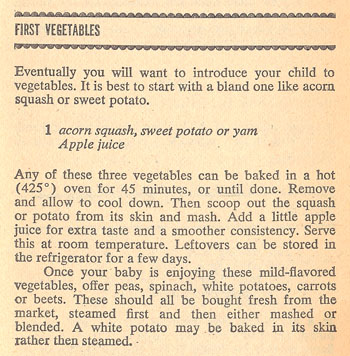
Here is a list of common ingredients in the recipe pages:
Fresh fruits, avocados, acorn squash, yams, carrots, potatoes, celery, green beans, milk, yogurt, cottage cheese, meats (purchased fresh from your local butcher), canned salmon (make sure it has no additives), barley, split peas, safflower oil, wheat germ, brewer’s yeast, Tigers milk, sesame seeds, coconut, powdered milk, peanut buttter, honey, raw sugar. Eggs are always specified as “eggs (raw)”. For flour, they suggest unbleached white flour OR use half soy and half whole wheat flours.
“Crepes” is one of the recipes. Below are some filling suggestions from Making Your Own Baby Food:
 I like this: “Needless to say this is just an occasional splurge and one not to be eaten by babies.”
I like this: “Needless to say this is just an occasional splurge and one not to be eaten by babies.”
The last section is the appendices. The suggested reading list (books) and the magazine bibliography (periodicals) and book and pamphlet lists are outdated (published by 1978) and not of much use to me. She included a bibliographic footnote list for each chapter. “Proposed Rules for Labeling Baby Foods” is a 10-page very small print reproduction of an article in the Federal Register, vol. 41, no. 174, September 7, 1976.
I did find it interesting to read Making Your Own Baby Food again. But, it this book will go into the recycle pile.
Update: one week later. I was fortunate enough to spend some time with my 8 month old grandson this week. We were at a park and fed him crackers and spaghetti. “What is this weird stuff” he seemed to be asking.
